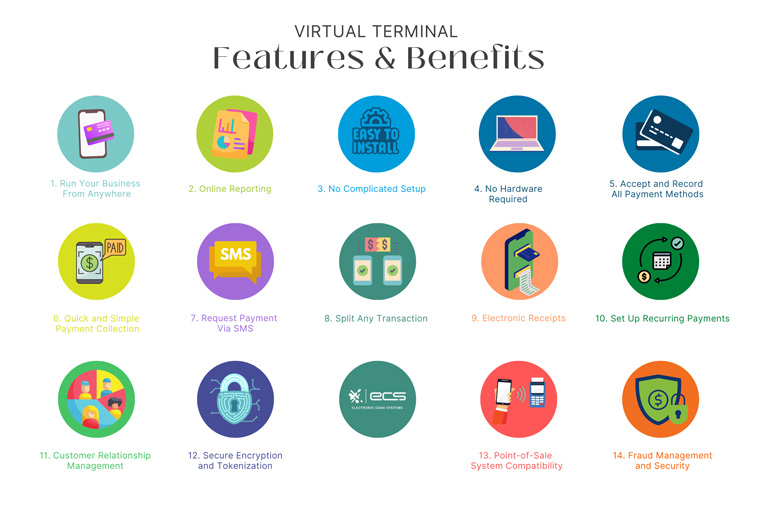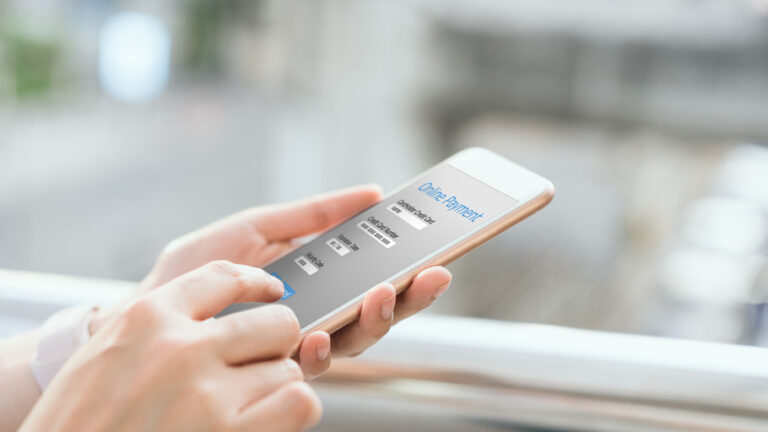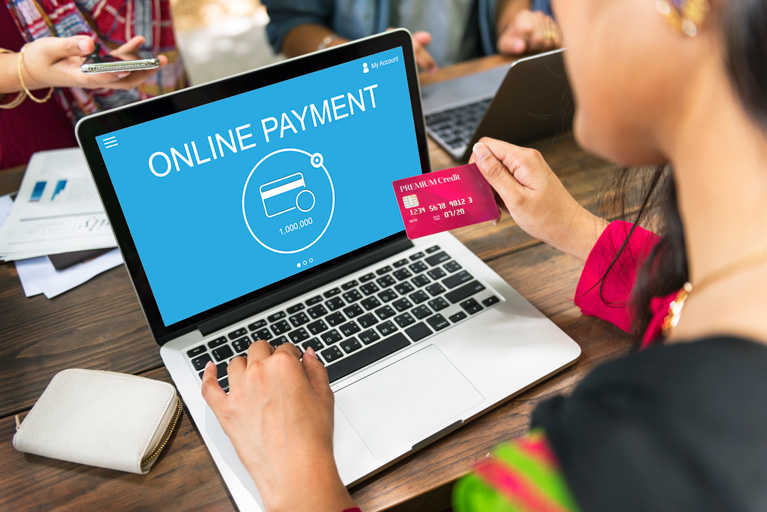If you own a business it’s time to explore flexible payment solutions. Learning more about virtual terminals and their many benefits can significantly increase your earning potential.
Virtual Terminal Versus Physical Terminal
All small businesses are unique. They operate according to specific individual needs. However, whether you own a family restaurant, a healthcare facility, a design boutique, or an eCommerce store, you share a common need. The ability to easily accept digital payment- debit card, credit card, and ACH – efficiently and securely.
Point-of-sale (POS) systems and countertop payment terminals might be the best solution for some businesses. But it might not be for others. These solutions are best suited for in-person payments.
However, many small businesses today operate solely online. Therefore, physical terminals may not be the best option. Additionally, some businesses may operate in person but offer the option for their clients to pay online. Or even set up recurring payments. In these situations, merchant virtual terminals may be the best solution.
Virtual Terminals for Small Businesses
Large corporations have efficient transaction experiences. To compete, small businesses need to be quick to react to their customer’s needs. Luckily, with modern-day advancements, payment processing options for small businesses are increasing. Using virtual terminals to process payments can be one of the simplest solutions.
Let’s take a look into the specifics of what virtual terminals are, how they work, what their features are, and who can best benefit from using them.
What is a Virtual Terminal For Processing Credit Cards?
A virtual terminal is a software or application that allows businesses to accept credit card payments right from their computer. It turns merchants or customers’ computers or smart devices into an online payment terminal.
Virtual card payment processing requires no additional equipment such as a physical terminal. Additionally, merchants will not need to pay for their software or application. Simply put, virtual payment terminals are a no-hassle, web-based payment platform. Allowing merchants to easily accept online payments.
Merchants and customers can complete a transaction anywhere and anytime. So long as they have:
- an internet connection
- a web browser
- a merchant account through a merchant services provider
- a payment gateway
Can Virtual Terminals Process ACH?
Virtual terminals are a great solution for ACH processing. Rather than collecting paper checks via mail or in person, merchants can use their virtual terminal service to collect bank account and routing information.
It is a quick and easy process. One that will rack up fewer payment processing fees compared to credit card transactions. Especially card-not-present transactions.
Card-Present Vs. Card-Not-Present Virtual Terminal Transactions
Physical payment terminals generally facilitate card-present transactions. Whereas, a virtual reader can complete card-not-present transactions. This means cards are not dipped, swiped, or tapped to process a payment. A merchant or customer would simply key in their card information to the payment screen.
Keep in mind, with manual card entry, the transaction is considered a card-not-present even if the customer is present and has their card on them.
Virtual terminals allow merchants to process electronic payments. Regardless if the cardholder is in person, on the phone, or online. If a merchant chooses to, they may process in-person payments through their virtual terminal. Card-present transactions avoid the larger credit card fees from their payment processor.
All a merchant would need to do is attach a physical card reader to their computer with a USB. The merchant can then swipe, dip, or tap the physical card and run the payment through their online payment gateway.
Card-Present Vs. Card-Not-Present Virtual Terminal Transactions
With any payment processing solution, merchants need to have a merchant account. They do this through the application to and approval of a merchant service provider.
The same providers that supply physical terminals and other payment solutions usually also supply virtual terminal merchant services.
Once a merchant receives approval for processing, they would need to set up their virtual terminal credentials.
How to Process Virtual Credit Card Payments
Unlike learning how to set up a physical card reader, getting started with a virtual POS system is simple. Below are the steps you will take to process digital payments on your virtual terminal:
Open your computer, tablet, or smartphone’s internet browser.
- Type in your payment gateway URL.
- Log into the payment platform dashboard.
- Select virtual terminal
- Select sale or refund.
- Choose the payment type: credit, debit, or ACH (eCheck).
- Enter the amount.
- Key in the card number or bank account and routing number into the fields.
- If you have a connected card reader, you may choose to swipe, dip, or tap the card and skip step 8.
- Add any other required details: billing information, order number, customer name, address, etc.
- Click the submit button.
- The payment information is then securely sent through the integrated payment gateway
- The gateway then sends the payment information to the payment processor.
- The payment processor contacts the issuing bank of the customer to validate the card and available funds.
- The virtual terminal will then receive confirmation of the card’s approval or decline.
a. Note: ACH transactions are not instant. Although submitted successfully, an ACH may not be approved. The processor sends the bank the transaction request. Then the bank will respond a few days later with the approval or returned transaction information. - If a credit card is approved, the virtual terminal may have the option to email or text a copy of the receipt to the client. Additionally, a merchant can use their virtual POS printer to print receipts from their computer.

Who Benefits From a Virtual Terminal Merchant Account?
Different types of business models may work best with one type of point-of-sale terminal vs another. For example, businesses that have a physical brick-and-mortar storefront that handle sales in person, like retail shops and restaurants, are better suited for a physical card reader.
Conversely, eCommerce businesses will find it more convenient to process payments online with a credit card processing virtual terminal. Additionally, just because a merchant is an in-person operation does not always mean a physical terminal is the best option for them.
Virtual terminals can also be a better fit for merchants that offer in-person services but travel or offer ACH and money transfers. Moreover, brick-and-mortar establishments, like restaurants, can also use virtual terminals to process over-the-phone or online orders.
The versatility of virtual credit card terminals benefits many types of business operations such as:
- Small business start-ups
- Tax professionals
- Attorneys
- Doctor offices
- Creatives
- Plumbers/electricians/handy-man
- Food & Beverage industry
- Money Service Businesses
- In-home businesses
- Traveling merchants
- Remote businesses
- Door-to-door service-based businesses
- Freelance merchants
- Restaurants that take over the phone orders for pickup or delivery
- And any business that accepts over-the-phone payments, eCommerce or website payments, mail order payments, or recurring bill payments

Virtual Terminal Features & Benefits
A virtual terminal offers more than just online payments. There are additional features and benefits that merchants can take advantage of to help efficiently manage their business.

1. Run Your Business From Anywhere
With the flexibility of virtual terminal solutions, merchants can run their businesses from anywhere. Virtual terminals turn any computer or smart device into a payment device. This means merchants can run their businesses in their homes, on the go, or in a physical storefront location.
They can have flexible business hours and locations. And they can collect payment even when they are not open. With virtual terminals, customers can process transactions online on their own. The merchant does not need to be present to complete a payment.
2. Online Reporting
Virtual terminals offer up-to-date reporting for all digital transactions. Depending on the merchant’s virtual terminal provider, these reports can be in real-time.
Advanced reporting tools allow merchants to view and download reports. Merchants can filter these reports by criteria such as date range, card type, amount, last 4 card digits, account holder name, and transaction status.
Additionally, providers may offer reports that show all the merchant’s batch and settlement information. Which means reconciliation is a breeze.
3. No Complicated Setup
Virtual terminals require no complicated setup to start processing. Once approved by their payment provider, a merchant receives their virtual terminal login credentials.
All the merchant would need to do is open the URL for their virtual terminal on their web browser, log in, and start processing payments.
4. No Payment Hardware Required
As a web-based solution, no additional payment hardware or special equipment is needed for a virtual terminal function. A merchant’s existing computer, smartphone, or tablet is instantly transformed into a payment portal. Merchants can simply key in and charge credit cards from any browser.
5. Accept and Record All Payment Methods
Virtual terminals can process credit cards, debit cards, and ACH transactions. They can complete a sale or refund. Additionally, if a physical card reader is attached via USB, virtual terminals can process card-not-present, as well as card-present transactions.
With the physical terminal, customers can tap, dip, or swipe their cards. The transaction information will automatically report itself in the merchant’s online gateway.
Moreover, not only do virtual terminals record digital payments, but merchants can also record cash, paper check, and gift card transactions in their payment portals.
6. Quick and Simple Payment Collection
When merchants adopt virtual terminals for card payments, they can collect payments faster. Businesses such as doctors’ offices that bill patients, can instead, set up recurring automatic payments. This eliminates waiting for a client to send a check or call in with payment information.

For client simplicity, rather than calling their doctor’s office, to make an over-the-phone payment, they can log in to the virtual terminal on their end. Patients can complete payment from the comfort of their personal computer or smart device.
7. Request Payment Via SMS
With a virtual terminal, merchants can request payment from their clients via SMS or text. The terminal will send a secure link directing the customer to the virtual terminal. Customers can privately complete their online payments from anywhere.
8. Split Any Transaction
Virtual terminals make it easy to split payments. The merchant can seamlessly collect the transaction total via different cards, gift cards, or cash. The merchant would simply need to select the “split payment” option and follow the directions on the screen.
9. Electronic Receipts
After a transaction has been completed successfully, a merchant is given the option to email, text, or print a receipt for the customer. The flexibility of how a receipt is issued helps keep customers organized and makes for a speedy checkout.
Additionally, digital receipts allow merchants to ask customers to provide feedback on their experience.
10. Set Up Recurring Payments
For merchants who have repeat customers, setting up automatic recurring payments provides great benefits for both parties. The merchant and their customers. With a card stored securely online, the virtual terminal automatically charges customers when payment is due.
When designing a payment plan that works for both parties, payments will automatically come in on time, every cycle. This will save a merchant time. Reducing the amount of manual entry required to process monthly payments.
Additionally, it will offer convenience and flexibility to customers. Consequently increasing cash flow and improving customer loyalty.
Many virtual terminals offer automatic recurring bill-pay solutions. However, not all providers have this feature. Make sure you research which merchant service providers offer this functionality if your business requires it.
11. Customer Relationship Management
Many virtual terminals provide a section for customer management. Where merchants can create customer profiles, view purchase histories, and add any additional notes. This feature will create better customer relationships. Helping merchants to know their customers on a more effective and personal level.
12. Secure Encryption and Tokenization
It is important to protect your cardholder’s data. Especially with PCI compliance guidelines. The design of virtual terminals enables the encryption of card data within your online gateway during a transaction.
Tokenization technology also provides merchants and cardholders peace of mind when storing card information online in the virtual terminal vault.
When the virtual terminal receives the entered card data, tokenization replaces the personal account number (PAN) with a randomized ID. Thus, encrypting and safeguarding sensitive information. Though this token is indecipherable, the payment processor can use it to complete transactions safely.
Tokenization and encryption free merchants from the risk of storing sensitive data in their systems. Minimizing PCI liability.
13. Point-of-Sale System Compatibility
Certain POS systems include virtual terminal compatibility. This functionality gives merchants the flexibility to accept payments even when they are away from their physical POS devices. Both the online terminal and the physical seamlessly connect. Therefore, a simple common dashboard helps merchants to account for and track all reports and transaction data.

14. Fraud Management and Security
When accepting card-not-present transactions with virtual merchant credit card processing, it is important to maintain proper anti-fraud measures. Card-not-present transactions usually require merchants to make sure the consumer making the transaction is the cardholder. And that they are in possession of the card.
Anti-fraud tools that virtual terminals uniquely supply include credit card vaults, two-factor authentication (2FA), address verification service (AVS), and credit card verification value (CVV) or card identification number (CID) confirmation.
Credit card vaults: If a merchant does a lot of repeat orders and billing, a virtual terminal can supply a credit card vault. This vault is a secure space within the virtual terminal site that encrypts and stores card information. This benefit makes it possible for automatic billing and repeat business without the hassle of pulling out a card to key in its information.
Two-factor authentication (2FA): 2FA uses 2 different factors to confirm the identity of the cardholder. Meaning, after the card number is keyed, the cardholder will need to confirm the transaction on a link sent by text to their cell phone or email.
Address verification service (AVS): AVS requests the customer to enter their billing address. The system will compare it to what their credit card-issuing bank has on file. Merchants can choose to verify either zip codes or full addresses.
Credit card verification value (CVV) or card identification number (CID): The CVV or CID is the 3-digit number on the back of a credit card. American Express credit card’s number is 4 digits on the front of the card. Retaining this number can help verify the legitimacy of the cardholder.
Cons of Virtual Terminal Credit Card Processing
The benefits and varying features of virtual credit card terminals are extensive. However, virtual terminal processing solutions will not meet all businesses’ needs. It is important to compare the solutions that virtual terminals offer and what they may not, to determine if it is the best option for you.

Manual Card Entry
Virtual terminals do not have a card reader. Therefore, merchants must enter their customer’s card information manually into their computers or smart device to process the payment. If you have a business with a high volume of unique tickets each day, then a virtual terminal may not be a solution that works for your business.

Keep in mind, virtual terminals are designed to store card information in vaults. So if you tend to have a lot of repeat customers, a virtual terminal can still work for you. It could be an add-on. However, you may want to consider also opting for a card reader for the best business functionality.
Higher Card-Not-Present Fees
Depending on the card fee model your payment processor uses, they may charge higher fees on card-not-present transactions. This is to cover the risk associated with these types of transactions.
Manually entered card-not-present transactions tend to have a higher chargeback and fraud rate. This is because the cardholder typically is not standing in front of the merchant. Which means identification and signatures cannot be verified.
The best way to keep costs to a minimum when using a virtual terminal for CNP transactions is to make sure to enter all the cardholder information. Some fields are not required, such as the cardholder’s full address. However, entering the field information in full will better help merchants with their fraud protection and dispute success.
Why Should I Get a Virtual Terminal?
The benefits virtual terminals offer are vast. And after digesting the comparison of virtual terminal benefits versus its downfalls, you may have a better understanding of what a virtual terminal can do for you.
However, whether or not you use one as your main credit card payment method, it can be beneficial to supplement your options for payment solutions. Having more than one option to accept digital payment offers small businesses the flexibility to shift, grow, and evolve alongside the economy.
As we have seen in recent years, we never know how the world market will change. Especially with the season we experienced with Covid-19. Situations like these may mean businesses need to rapidly pivot in how they function and accept payment. Card-not-present-payments may be a solution that will save merchants from losing business in troubling times.
Do Virtual Terminals Work on Mac and Windows PC?
Virtual terminals work on both Mac and Windows PC systems, as well as any brand of smartphone. This is because virtual terminals are browser-based. It is simply a digital POS system that processes credit cards online. All you need is a device that connects to the internet.
What’s the cost of a virtual terminal?
Many merchant service providers include virtual terminal solution features within their basic plan. Reach out to your payment provider or the providers you are considering to see if this is a benefit you can take advantage of at no extra cost.
However, the real cost of payment processing will come from a variety of factors. This includes your payment provider, fee plan, transaction volume, and any additional payment solutions you sign up for.
While these factors vary, most payment processor fees for virtual terminals work similarly. Typically there is a percentage a merchant will pay their processor for every transaction plus a set per-transaction fee. Additionally, some payment processors will charge a monthly fee.
Average processing rates range between 2.9% and 3.5%. And average per-transaction fees range between 15¢ to 30¢.
Finding the Right Virtual Terminal Provider For You
The best virtual terminal credit card processing company will be different for every merchant. Every business model has different needs, budgets, and priorities.
Every merchant service provider has different payment solutions and fee structures. You will need to compare different providers and see which one best suits your business needs with the highest value.
When doing your research on which payment processing provider is best for your business needs, you can ask yourself:
Do I Also Need Payment Hardware?
If your business model allows you to see customers in person, you may want to have both options to accept card payments. A virtual terminal, to accept payments from anywhere and when cardholders are not present, as well as a physical terminal for in-person payments.
Moreover, card-present-transactions will have lower interchange rates. Therefore, a combination plan of both types of terminals may be a solution that could help you save money on payment processing fees.
What is My Average Ticket Sale and Transaction Amount?
Knowing what your ticket amounts are and your average transaction costs will help you to better analyze payment processing companies’ fee plans. This will help you to determine which best suits your type of business.
If you have a lot of tickets, you may want to find one that offers lower per-transaction fees. Even if this comes with a higher interchange rate, it may save you more. There are many types of merchant fee structures to consider. Such as flat-rate pricing, interchange plus, and tiered.
Do I Need Any Extras?
Other than different fee structures, merchant service providers also offer different payment solutions. If you need multiple solutions that one company offers and another does not, you will have a better idea of who best fits your needs.

How To Get Started With a Merchant Virtual Terminal
For small businesses, remote businesses, traveling businesses, or eCommerce businesses to accept credit cards, virtual terminals may be the best answer for their payment processing solution.
If you believe a virtual terminal for credit card processing sounds right for you, ECS is happy to help. We will help you to determine all the solutions that will best fit your individualized business needs.
ECS offers virtual terminals, physical terminals, consumer financing, merchant lending, and so much more. Our knowledgeable and friendly team is ready to answer all of your virtual terminal and payment processing questions. We are excited to set you up for success.
To contact sales, click HERE. And to learn more about ECS Virtual Terminal visit Online Payments.
